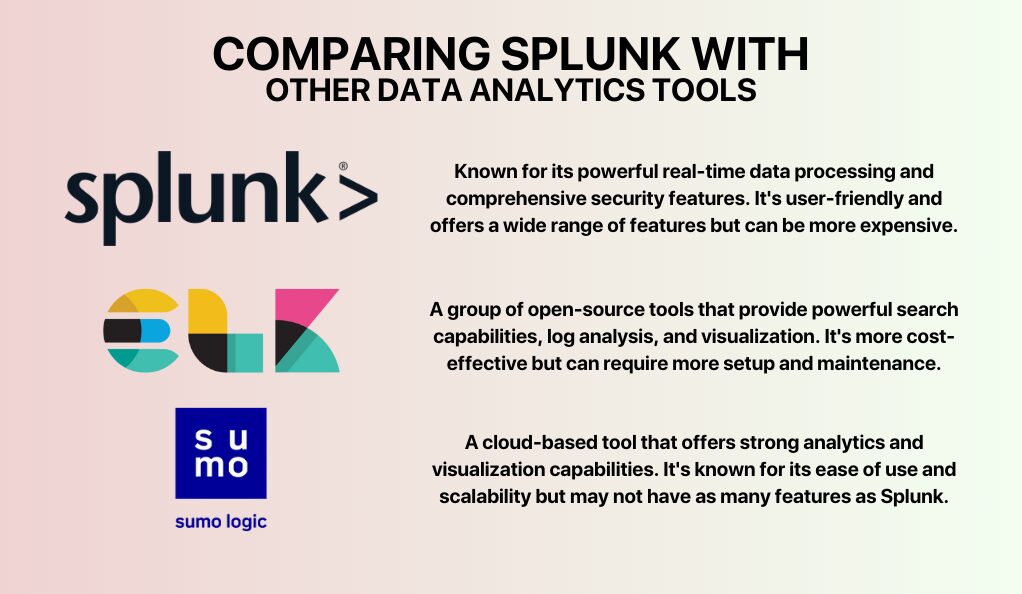From Zero to Splunk Hero: A Beginner’s Guide to Data Analytics
Splunk is more than just a software; it’s a powerful tool that has transformed the way businesses handle big data. Imagine a world where every click, every search, and every scroll on your website generates data. This data is valuable, but only if you can make sense of it. That’s where Splunk comes in.
First introduced in 2003, Splunk started as a simple idea: to make it easier for businesses to understand the mountains of data their systems were generating. Over the years, it has evolved into an essential tool for data analytics. Splunk helps businesses sift through this data quickly and efficiently, turning it into actionable insights.
Think of Splunk as a detective. It takes in all the clues (in this case, data) from different sources, analyzes them, and helps solve the mystery (which could be anything from identifying security threats to improving customer experience). It’s not just about collecting data; it’s about understanding it.
Splunk’s ability to handle massive amounts of data in real time has made it a go-to solution for companies across the globe. Whether it’s for monitoring IT systems, ensuring security compliance, or gaining insights into customer behavior, Splunk has proved to be an indispensable part of modern data management.
How to Use Splunk for Machine Data Analytics
Splunk has become a key player in the world of machine data analytics. It’s like a powerhouse that turns complex, machine-generated data into clear, actionable insights. Machine data is everything your computers, servers, and applications are recording every moment – from logs to transactions. This data is incredibly valuable for understanding how your systems are performing and making smart business decisions.
Understanding Machine Data with Splunk
Machine data can be overwhelming. It’s like trying to read a book written in a language you don’t understand. Splunk helps translate this complex data into a language that’s easy to understand. It collects data from various sources, indexes it, and makes it searchable. This process allows Splunk to turn raw data into meaningful reports, charts, and alerts.
- Data Collection: Splunk gathers data from multiple sources, like servers and applications.
- Data Indexing: It organizes the data, making it easy to search.
- Data Analysis: Splunk analyzes the data, helping you identify trends and patterns.
Making the Most of Splunk
To really harness the power of Splunk in machine data analytics, consider the following steps:
- Define Your Goals: Understand what you want to achieve with your data. Are you looking to improve performance, security, or something else?
- Set Up Data Inputs: Configure Splunk to collect data from the right sources.
- Customize Your Dashboards: Create dashboards that give you the most useful view of your data.
- Regularly Review Data: Regularly check your Splunk dashboards and reports to stay updated.
A Closer Look at Splunk’s Capabilities
Splunk’s Real-Time Monitoring
Real-time monitoring is one of the most significant features of Splunk. It’s like having a security camera that watches over your IT infrastructure 24/7, alerting you the moment something unusual happens. This immediate insight is crucial for quickly addressing potential issues.
- Alerts: Set up alerts for unusual activity or system errors.
- Live Dashboards: Use live dashboards to monitor system performance in real time.
Leveraging Splunk for Business Insights
Beyond IT monitoring, Splunk can provide deep insights into business operations. It can track customer behavior, monitor transactions, and even predict future trends based on historical data.
- Customer Behavior Analysis: Use Splunk to understand how customers interact with your applications.
- Transaction Monitoring: Keep an eye on transaction logs to ensure smooth business operations.
Incorporating Splunk into your data analysis strategy can transform the way you view and utilize your machine data. By translating complex data into actionable insights, Splunk empowers businesses to make smarter, data-driven decisions.
Key Features and Benefits of Splunk
Splunk stands out as a unique and powerful tool in the world of data analytics, offering a suite of features that makes it invaluable for businesses. Its ability to manage and analyze vast amounts of data in real-time, coupled with its user-friendly interface, makes it a preferred choice for many organizations. Splunk is not just about collecting data; it’s about making that data work for you.
Understanding the Core Features of Splunk
At its heart, Splunk is designed to handle the complexities of big data, making it simpler and more manageable. Its core features include:
- Data Collection and Indexing: Splunk can ingest data from various sources, indexing it for quick search and analysis.
- Real-Time Processing: It offers real-time data processing, allowing for immediate insights and action.
- Advanced Data Analytics: With its powerful analytics engine, Splunk can uncover deep insights from your data.
- Customizable Dashboards: Users can create personalized dashboards to view the most relevant data in a convenient way.

The Benefits of Using Splunk
The advantages of incorporating Splunk into your business strategy are many. They range from improved operational efficiency to enhanced decision-making. Here are some key benefits:
- Enhanced Operational Efficiency: By automating the collection and analysis of data, Splunk saves time and resources.
- Better Decision Making: With real-time insights, businesses can make informed decisions quickly.
- Improved Security: Splunk’s ability to monitor systems in real-time helps in early detection of security threats.
- Scalability: Whether you’re a small business or a large corporation, Splunk scales with your needs.
Splunk in Action: Practical Uses
Splunk for IT and Security
In the IT and security domain, Splunk acts like a vigilant guard. It monitors network traffic, identifies potential threats, and helps in quick resolution of IT issues.
- Threat Detection: Splunk’s real-time monitoring helps in early detection of security threats.
- IT Troubleshooting: Quickly identify and resolve IT problems to minimize downtime.
Splunk for Business Analytics
Splunk is not limited to IT and security. Its application extends to providing business insights, helping companies understand customer behavior, and improving operational efficiency.
- Customer Insight: Gain a deeper understanding of your customers’ needs and behaviors.
- Operational Intelligence: Use data to streamline operations and enhance productivity.
By integrating Splunk into your data strategy, you open up a world of possibilities for data analysis and business intelligence. Splunk turns raw data into actionable insights, helping you stay ahead in the competitive business landscape.
How to Implement Splunk in Your Organization
Implementing Splunk in your organization is a strategic move towards smarter data management and analytics. It’s about taking all that complex data your systems generate and turning it into something useful and insightful. The process involves a few key steps but can lead to significant improvements in how your business handles and interprets data.
Setting Up Splunk for Your Business
Starting with Splunk may seem daunting, but it’s quite straightforward when you break it down into manageable steps. Here’s how you can get started:
- Define Your Objectives: Understand what you want to achieve with Splunk. Is it better security monitoring, improved operational efficiency, or deeper customer insights?
- Choose the Right Version: Decide whether Splunk Enterprise or Splunk Cloud is best suited for your needs.
- Install and Configure: Set up Splunk, which involves installing the software and configuring it to collect data from your designated sources.
- Customize Your Setup: Tailor Splunk to meet your specific requirements, from setting up dashboards to creating alerts.
Making the Most of Splunk in Your Organization
To truly benefit from Splunk, it’s not just about setting it up. It’s also about integrating it effectively into your daily operations.
- Train Your Team: Ensure your team understands how to use Splunk. Consider Splunk’s own training resources or other external training programs.
- Regularly Review Data Insights: Regularly check the insights Splunk provides. This can help in making timely decisions and adjustments in strategies.
- Stay Updated: Keep your Splunk setup updated with the latest features and improvements.
Splunk as a Catalyst for Change
Transforming Data Management and Analysis
Implementing Splunk can be a game-changer for your organization. It can transform the way you manage and analyze data, leading to more informed decisions and better business outcomes.
- Improved Decision Making: With real-time data at your fingertips, decision-making becomes quicker and more accurate.
- Enhanced Efficiency: Automating data analysis frees up time for your team to focus on other critical tasks.
By adopting Splunk, you’re not just adding a new software to your tech stack. You’re empowering your organization with the tools to make the most out of your data. This can lead to significant improvements in various areas of your business, from operations to customer service. Implementing Splunk is a step towards a more data-driven and efficient future for your organization.
Comparing Splunk with Other Data Analytics Tools
When it comes to data analytics, Splunk is a big name, but it’s not the only option out there. Understanding how Splunk stacks up against other tools like ELK Stack and Sumo Logic is crucial for making an informed decision. Each of these tools has its own strengths and features, making them suitable for different needs and scenarios.

Splunk vs. ELK Stack vs. Sumo Logic
- Splunk: Known for its powerful real-time data processing and comprehensive security features. It’s user-friendly and offers a wide range of features but can be more expensive.
- ELK Stack (Elasticsearch, Logstash, Kibana): A group of open-source tools that provide powerful search capabilities, log analysis, and visualization. It’s more cost-effective but can require more setup and maintenance.
- Sumo Logic: A cloud-based tool that offers strong analytics and visualization capabilities. It’s known for its ease of use and scalability but may not have as many features as Splunk.
Here’s a simple comparison:
| Feature | Splunk | ELK Stack | Sumo Logic |
|---|---|---|---|
| Real-time Data Processing | Excellent | Good | Very Good |
| User-Friendliness | Very Good | Good | Excellent |
| Cost | Higher | Lower | Moderate |
| Setup and Maintenance | Easier | More Complex | Easier |
| Scalability | Excellent | Good | Excellent |
Choosing the Right Tool for Your Needs
Selecting the right data analytics tool depends on several factors:
- Budget: Consider how much you’re willing to invest in a data analytics tool.
- Technical Expertise: Assess the technical capability of your team to manage and maintain the tool.
- Specific Needs: Identify the specific features you need, like real-time processing, security, or ease of use.
Splunk: A Versatile Choice in Data Analytics
Adapting to Diverse Business Requirements
While each tool has its advantages, Splunk often stands out for its versatility and adaptability to different business needs. It offers a balance of ease of use, powerful features, and scalability, making it a go-to choice for many organizations.
- Balanced Approach: Splunk strikes a balance between functionality, ease of use, and cost, making it suitable for a wide range of applications.
- Widely Used: Its popularity means a larger community and more resources for troubleshooting and learning.
While Splunk might be the right choice for many, it’s important to weigh your options and consider what tool aligns best with your organization’s specific needs and capabilities. Each tool has its unique strengths, and the best choice will depend on your particular requirements, budget, and technical expertise.
Conclusion
Splunk has firmly established itself as a crucial player in the realm of data analytics, transforming how organizations interpret and utilize vast data. It’s not just a tool for collecting information; Splunk translates complex data into actionable insights, enhancing decision-making and operational efficiency across various industries. Whether it’s for IT monitoring, security, or gaining deep business insights, Splunk offers a comprehensive, user-friendly solution. As we advance into an increasingly data-driven era, the significance of Splunk in processing and analyzing data continues to grow. It adapts to the evolving demands of the digital world, empowering businesses with the tools to harness their data effectively. Splunk’s blend of real-time data processing, detailed analytics, and adaptability makes it an indispensable asset for any organization striving to make informed, data-driven decisions, ensuring its relevance and efficacy in the future of data analytics.


Leave a Reply